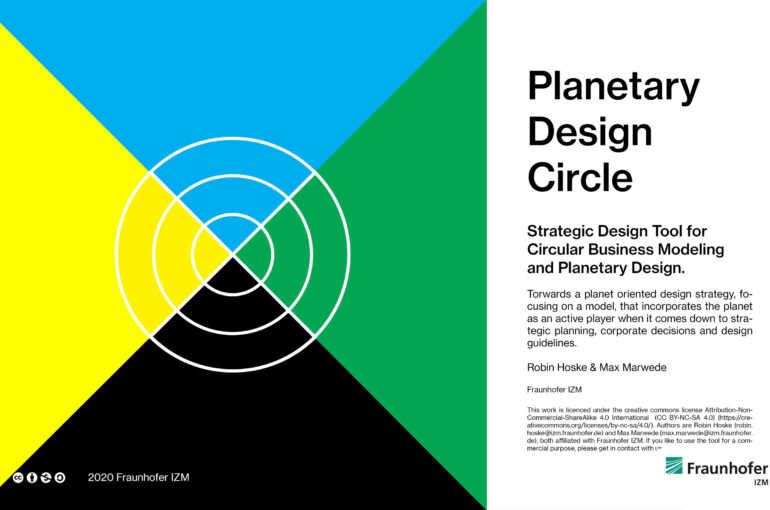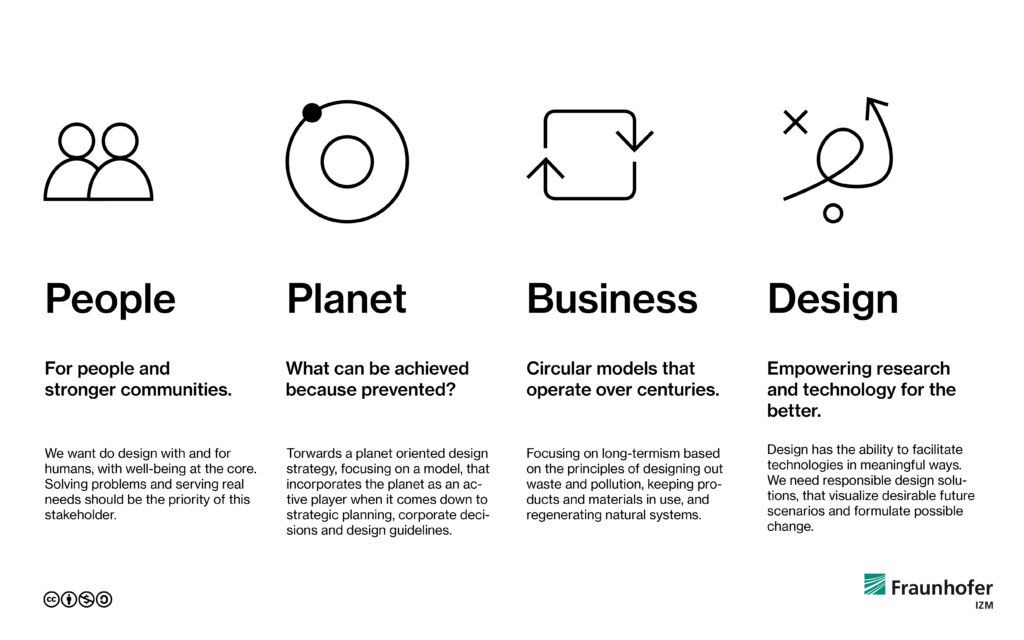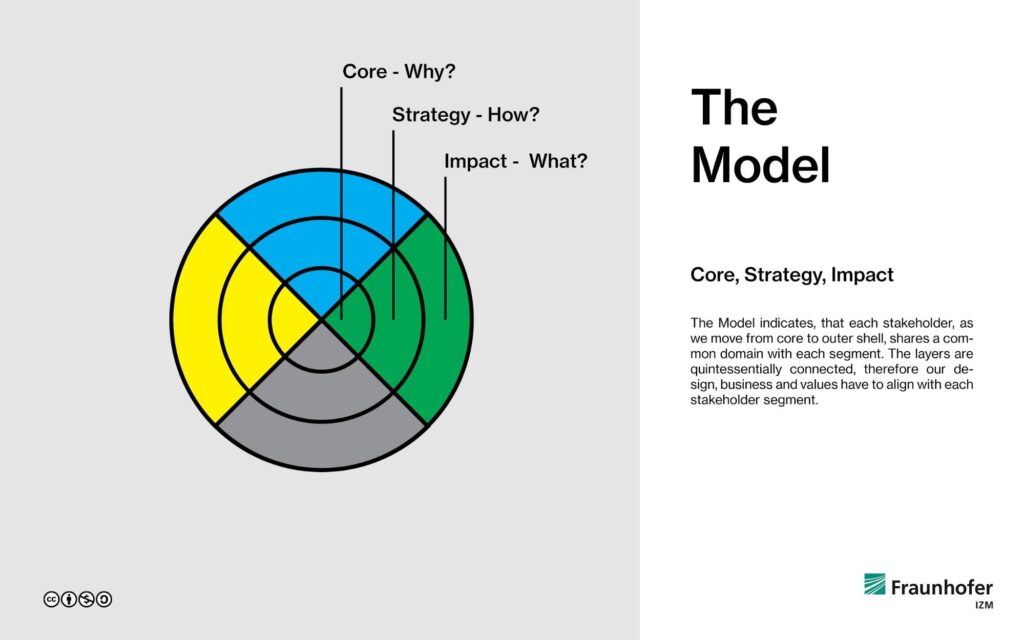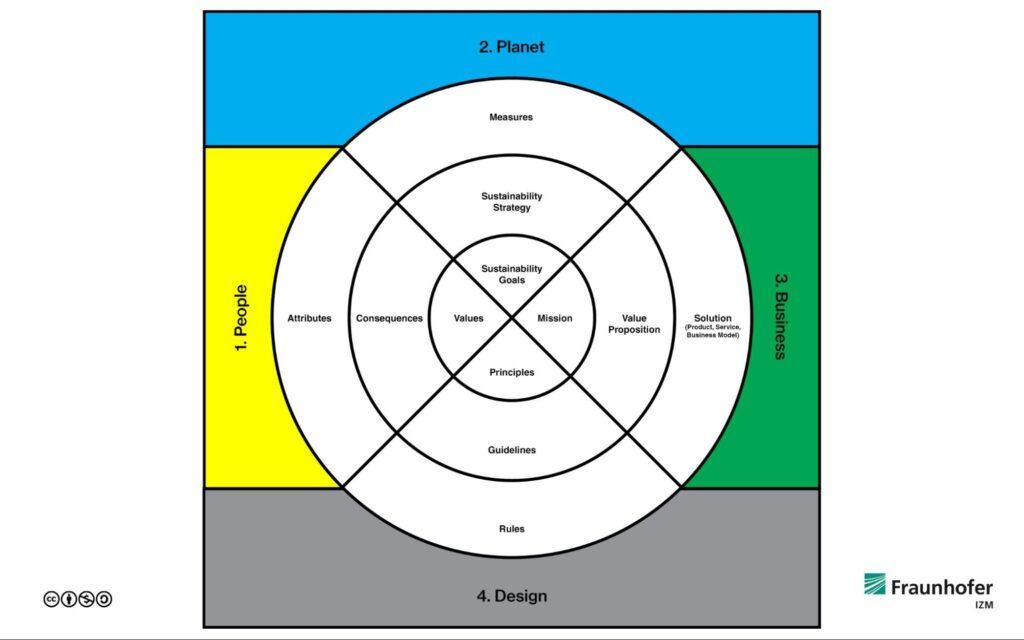Planetary Design Circle – A Holistic and Strategic Design Tool

Authors: Hoske, Robin; Marwede, Max – Fraunhofer IZM
The past months were a time that changed the way we work and collaborate together with our artists. With the Pandemic we were once more reminded that there is an urgent need for a change within the way we think, design and collaborate with our environment.
We used the time to come up with a new collaborative method to remotely develop sustainable design solutions with all our artist teams. We now would like to make the “Planetary Design Circle” available for everyone, a strategic design tool for circular business modeling, putting the planet first.

Why did we come up with a new tool?
At Fraunhofer IZM we are used to assess environmental impacts of products, identify problematic usage of hazardous materials or identify resource-intensive processes. However, we are often dealing with technologies which are already in place. For the co-creation of design concepts needed a tool that merges creative design thinking with environmental responsibility and complex stakeholder analysis. Furthermore, it should be applicable during the early stage of the design process when many things are still unknown or undecided. We realized that our current methods of design thinking lack a broader view of the complex systems and relations we design in and for.
The Background: Human Centric Design – The Golden Filter of UX Design
We based our approach on the “human-centric” design approach, in which the user is put in the focus of creation, helping to find useful solutions that solve real needs for people. Danieel De Wit proposed a model that merges the approaches to have a clear view of the context of design problems. In his article “the Golden Filter of UX Design” De Wit imagines a model that teaches us how to create human centered design, while also taking into account business, technology and other factors.

Clarifying the “Why” the “How” and the “What” helps to find a hierarchy of why a company is developing a certain product to how they are solving problems on a product level.
Our Tool – the Planetary Design Circle
But as we currently face new challenges in design, with a stronger need for circular and sustainable solutions, we need to incorporate the planet as an active stakeholder. Our model is an attempt to visualize and summarize our intentions (Why, How, What) in order to find actionable design solutions which are aligned to the planetary needs (i.e. environmental and social requirements) . As we often see, intentions and ideas create conflicts between different stakeholders including the “planet”. These conflicts should be addressed right from the start.

The Design Process
From our point of view it makes sense to start with the user research (1). The “What” i.e. the attributes (functions, aesthetics, brand, …) determine usually why someone is choosing a certain product, service or solution: e.g. “The trainer fits well”. If you ask a person why they choose a solution, they usually answer with the underlying needs, i.e. the purpose. In our case for example: “I can go running without hurting my knees”. If you then ask why jogging is important for that person, the answer might be: “I like to be fit” – then you disclose the values of the person.
If you know the values and attitudes of your target group, it’s easier to align your business motive or mission (3) with your target group and also determine which sustainability goals would actually address the values of the users and thus makes selling “sustainability” easier. The development of a sustainable value proposition (2) should address the needs of the user and through certain sustainability strategies the planet as a stakeholder (or representatives of the planet like policy bodies or NGOs). During the final stage in the business section you decide which specific solution (product, service, business model) you like to provide to the user. After defining the upper three sections – People, Planet and Business – you come up with your design.
In the design phase you go through the same three main stages, Why, How and What. The peculiarity of the system is, that you now have to match the three levels with the previous findings to come up with a suitable design:
- Why do you need to design? At this stage, you can formulate statements that frame more specific principles for the final product. By formulating these statements, you start to build up the product upon the initial reason you are designing for.
- You then transfer these principles to the next stage, the How, and try to formulate guidelines. The guidelines need to match the consequences and attributes you formulated earlier and they should also comply with the strategy that is set to achieve business and planetary goals.
- In the last phase, the What, you translate this into a set of rules telling you how to design and how to tackle the product solution in detail. Maintaining a certain hierarchy, allows our to trace back a certain design solution to its origin and to test it against your initial principles and values. This enables you to maintain ecological or social goals and to direct the solution towards a value-based development.
As you can see this process is not linear. With which section or field you start is up to you. You might already have a technology in mind and want to address the user with a specific business model (i.e. solution) and need to come up with the appropriate design for the technology. Thus, it is a very versatile tool which helps you to determine the best design from a business, planetary and user perspective.
How can Designers integrate Planetary Thinking in their Design Process?
We tested the model with our artists and took them through each section to create individual maps of their undertakings. Thereby, we could create an overview of all ideas and their impact further on in the production and use cycle. Mapping their solution and technologies helped us to identify problematic areas or conflicts that were not foreseeable in the bigger picture before.
For example, the team ALMA realised that one of their core values is the empowerment of women through healthcare education. They realised that the current technological solution might not reach all potential women due to a gap in income, lack of access to new technologies or cultural barriers.
The planetary design approach also revealed that their solution could be an active mean in reducing the footprint of the hygiene industry and lowering the use of one-time medical tests. It therefore needs to be kept in the use cycle as long as possible. The design should be modular, have changeable components, and be sanitizable and repairable.
Conclusion
We successfully tested the tool with various teams and would like to make it available to everyone. We saw that the tool helped the teams to keep an overview of their design projects as well as identify conflicts and synergies between different sections. It helps to align the design with the user needs, the solution and the sustainability strategies. It also supports variable solutions for different market segments. Furthermore, it can be used in co-creation processes as it simplifies the exchange and communication across the team., You can of course add, adapt and clarify certain topics along the design process. The tool including a comprehensive description how to use it is available for download here. If you have any questions on how to use it or ideas on how to improve feel free to contact us. Published under the licence condition CC BY-NC 4.0 it can be modified to your needs. In case you wish to use the tool for commercial purposes, please get in contact with us. Robin Hoske (robin.hoske@izm.fraunhofer.de) and Max Marwede (max.marwede@izm.fraunhofer.de).





